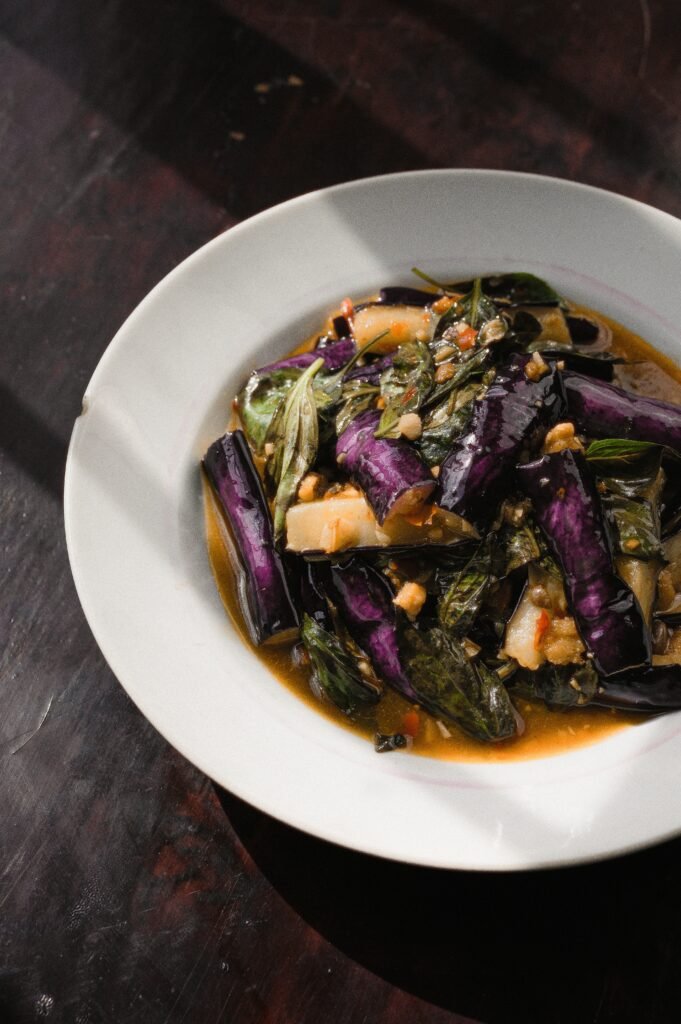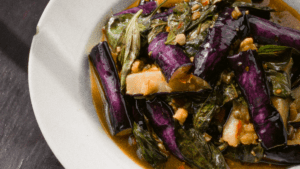 This dish is an adaptation of the famed Sichuanese dish yúxiāng (“fish-fragrant”) eggplants. It accents the aroma of Taiwanese basil while keeping the umami, spice, tang, and sweet notes of the original version. Instead of textured vegetable protein, you can also use crumbled firm tofu.
This dish is an adaptation of the famed Sichuanese dish yúxiāng (“fish-fragrant”) eggplants. It accents the aroma of Taiwanese basil while keeping the umami, spice, tang, and sweet notes of the original version. Instead of textured vegetable protein, you can also use crumbled firm tofu.

Basil-Fragrant Eggplant
Ingredients
- 2 Asian long eggplants (400g total)
- 1-3/4 cups plus 1 tablespoon water
- 2 tablespoons rice vinegar
- 1/4 teaspoon salt
- 1-1/2 tablespoons (10g) textured vegetable protein mince (TVP) 素肉丁
- About 1 cup neutral oil, for frying
- 1/2 teaspoon potato starch or cornstarch
- 8 garlic cloves, minced, or 1 tablespoon peeled and minced ginger
- 1 teaspoon Fermented Chili Paste 辣椒醬 (above)
- 1 tablespoon dòubànjiàng (chili bean paste) 豆瓣醬
- 1/2 tablespoon light soy sauce
- 2 teaspoon granulated sugar
- 1 handful (about 15g) Taiwanese basil leaves 九層塔 or Thai basil leaves
Instructions
- Trim both ends off each eggplant. Cut them crosswise into 2-1/2-inch segments and halve those segments twice lengthwise to create batons. In a large bowl, combine the eggplant, 1 cup of the water, the rice vinegar, and salt. Stir to coat all the pieces and let soak for 10 minutes. Drain the eggplant batons and set them aside.
- In a small bowl filled with hot water, soak the TVP for about 10 minutes, until springy and expanded. Drain into a sieve. Rinse and squeeze the TVP until its liquid runs clear. Set aside.
- Line a plate with paper towels. In a wok over medium-high heat, warm the neutral oil to 355°F (180°C). Fry the eggplants in three or four separate batches to avoid overcrowding. Fry each batch for 1 to 2 minutes, until the skins are deeply purple and the white flesh just starts to caramelize at the edges. Using a spider strainer or slotted spoon, transfer each batch to the towel-lined plates to drain.
- In a small bowl, make a slurry with the potato starch and 1 Tbsp of the water. Mix until no lumps remain and set aside.
- Pour out all but 1 to 2 tablespoons of the oil in the wok and heat over medium heat. Add the TVP and fry for 3 to 5 minutes, until just golden. Add the garlic, fermented chili paste, and dòubànjiàng and fry to stain the oil red, 1 to 2 minutes. Swirl in the light soy sauce. Add the remaining 3/4 cup water and the sugar and bring to a boil. Add the fried eggplants back in and toss a few times. Stir the slurry to make sure it’s incorporated and drizzle it into the mixture to thicken the sauce. Remove the wok from the heat and add the basil. Taste and adjust the seasoning as needed. Transfer to a plate and serve immediately.
Notes
 Recipe reprinted with permission from A-Gong’s Table by George Lee (Ten Speed Press, an imprint of Crown Publishing Group, a division of Penguin Random House LLC, New York., 2023). Photography by Laurent Hsia.
Recipe reprinted with permission from A-Gong’s Table by George Lee (Ten Speed Press, an imprint of Crown Publishing Group, a division of Penguin Random House LLC, New York., 2023). Photography by Laurent Hsia.